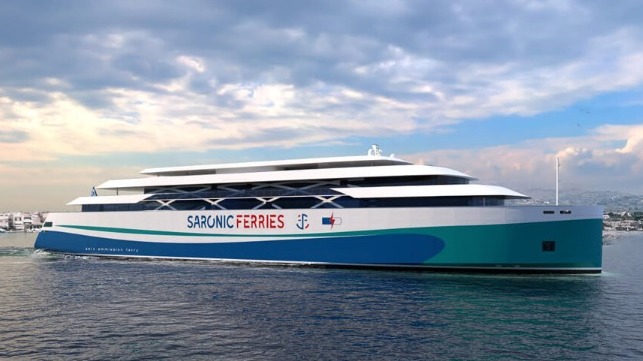Designs for Large Electric RoPax Ferry to Operate in Greece

Deployment of electric ferries so far is mostly limited to short-sea and coastal routes but in the latest development Greece’s Saronic Ferries today announced their partnership with C-Job Naval Architects to develop the design of the first fully-electric RoPax ferry in Greece.
“We are taking a step towards a cleaner world and we envision our operation in the Saronic Islands to be the inspiration for others to initiate more green fleet renewal projects in Greece,” said George Papaioannides, a partner in Saronic Ferries. The company, which is the largest ferry operator to Greece’s Saronic islands, currently has five older ferries sailing between Piraeus and the islands of Aegina, Agistri, Methana, and Poros. They operate year-round providing both transportation for local commuters and professionals as well as tourists and numerous visitors to Greece during the tourist season.
The design for the ferry features a variety of sustainable aspects, including fully electric propulsion. It is also larger than most of the current electric designs and would be exposed to more weather and sea conditions while crossing the Aegean from Piraeus to the islands.
The design calls for a 279-foot long RoPax that would have a beam of 52 feet. It would accommodate up to 800 passengers. It would also transport 85 cars or a combination of six trucks along with space of up to 55 cars.
Details were not announced of the proposed power plant and propulsion for the ferry but they reported it would recharge while in Piraeus. Its top speed would be 14.5 knots. The design would also include state-of-the-art energy-saving solutions and top-in-its-class interior design.
“We are leading the way encouraging potential stakeholders to embrace change and move things forward, both on the vessel design front and the land-based infrastructure and supply. One can’t come without the other,” said Joseph Lefakis, another one of the partners in Saronic Ferries.
C-Job, which is working on several innovative designs including a liquid-hydrogen tanker barge to create the supply chain from production through delivery to the end-user for hydrogen, reports that it approached the ferry design by conducting an extensive sustainable fuel feasibility study.
“We’ve been researching alternative fuels and energy sources for nearly a decade and have applied this knowledge and other innovations to our designs. Thanks to our experience and R&D team, we’re able to show how design choices will affect operations and create the optimal design for each situation,” said Nikos Papapanagiotou, Director of C-Job Athens.
According to the companies, the ferry is designed to sail between Piraeus and the islands of Aegina and Agistri, as the first step in Saronic Ferries's goal to operate an emissions-free fleet by 2040. The ferry could enter service by 2026, provided the power infrastructure required in the port of Piraeus is in place.
